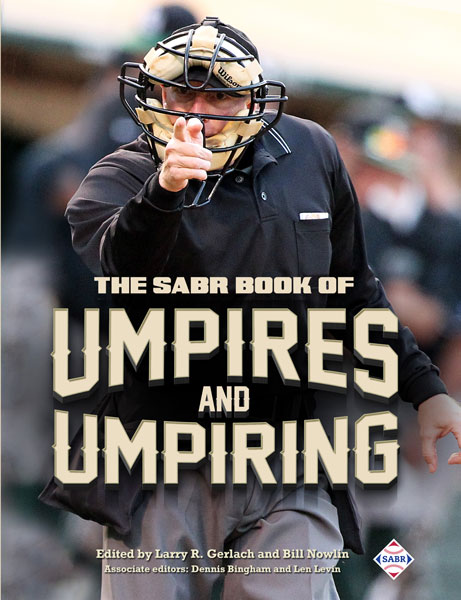Introduction: The SABR Book of Umpires and Umpiring
This article was written by Larry Gerlach
This article was published in The SABR Book of Umpires and Umpiring (2017)
“At the time set for beginning the game the players of the home team shall take their defensive positions, the first batter of the visiting team shall take his position in the batter’s box, the umpire-in-chief shall call “Play,” and the game shall start.” — Official Baseball Rules, 2016 Edition
 Play!” With that simple directive, umpires not only start a baseball game, but also ensure that it is played according to the rules. Although umpires are an essential component of the national pastime — no umpires, no organized game — they are little appreciated or understood, even by many ardent fans. Indeed “Blue,” the traditional spectator’s designation for an umpire, has historically been ridiculed for presumed incompetence or demonized for unpopular decisions. If organists no longer play “Three Blind Mice” à la Ebbets Field’s Gladys Goodding, and the homicidal refrain “Kill the Umpire” is rarely heard, umpires still receive little respect for their game-time functions.
Play!” With that simple directive, umpires not only start a baseball game, but also ensure that it is played according to the rules. Although umpires are an essential component of the national pastime — no umpires, no organized game — they are little appreciated or understood, even by many ardent fans. Indeed “Blue,” the traditional spectator’s designation for an umpire, has historically been ridiculed for presumed incompetence or demonized for unpopular decisions. If organists no longer play “Three Blind Mice” à la Ebbets Field’s Gladys Goodding, and the homicidal refrain “Kill the Umpire” is rarely heard, umpires still receive little respect for their game-time functions.
Even less appreciated is the umpiring profession — requiring initial attendance at a training school, lengthy apprenticeship in the minor leagues, arduous travel and familial stress of a career spent largely away from home, administrative procedures before and during games, and the systematic human and technological evaluations of performance.
While biographies and autobiographies of players and managers abound, with few exceptions anonymity characterizes the guardians of the game. Umpires are people, too, their personalities and private lives not add only a human dimension to the game but also insight into the character of those who have served since the 1840s.
In short, the umpire remains a conspicuously missing chapter in the otherwise extensively documented history of baseball. Astonishingly, James Kahn’s The Umpire Story (1953) remains the lone general history. Over the course of more than 150 years, the history of baseball is reflected in the extraordinary development of the profession of umpiring from the initial presence of a gentleman arbiter charged with maintaining decorum to the emergence of the tough-minded lone rules enforcer of the formative professional era; from the creation of multi-member crews and the dominance of individual personalities and styles prior to World War II; and from the postwar emergence of the training schools, unionization, and the appearance of African American and Latino umpires to the current financial security and technological enhancements of a modern profession.
And at each stage umpires and umpiring mirrored the transformation of the game itself within the larger American society. For all the changes, and there were many, there remained one constant: the integrity and dedication — indeed love of the game — of those who by enforcing the rules made it possible to play the game in an orderly fashion. To Jacques Barzun’s famous dictum — “whoever wants to know the heart and mind of America had better learn baseball” — one might add: “whoever wants to know baseball had better learn about umpires.”
This volume is something of a companion to Can He Play? A Look at Baseball Scouts and Their Profession, a previous SABR publication that called attention to another group of important if neglected contributors to the national pastime. Intended partially to fill the void, herein are biographies of prominent umpires including the 10 members of the National Baseball Hall of Fame; accounts of major historical events and lists of performance records; cultural and literary representations; interviews with contemporary individual umpires and crews as well as ballpark support personnel; and the descriptions of current administrative and technological supervisory systems. While the material predominantly deals with major-league baseball, there are also accounts of other professional, amateur, and international umpiring.
Although the book provides an expansive view of umpires and their profession past and present, selectivity governed inclusions. The contents reflect the editors’ inclinations as well the research contributions of SABR members. Undoubtedly some readers will regret that this umpire or that topic has been omitted, but hopefully all will appreciate and benefit from what has been included. And hopefully, in keeping with SABR’s core mission, the book will inspire additional biographical and historical research into an essential, if neglected, component of the national pastime.
LARRY GERLACH, past president of SABR, is the author of The Men in Blue: Conversations With Umpires, and co-editor with Bill Nowlin of The SABR Book of Umpires and Umpiring.
- Read more: Find all essays from The SABR Book of Umpires and Umpiring in the SABR Research Collection online
- BioProject: Find more biographies on umpires at the SABR Baseball Biography Project
- E-book: Click here to download the e-book version of The SABR Book on Umpires and Umpiring for FREE from the SABR Store. Available in PDF, Kindle/MOBI and EPUB formats.
- Paperback: Get a 50% discount on The SABR Book on Umpires and Umpiring paperback edition from the SABR Store ($17.99 includes shipping/tax).


